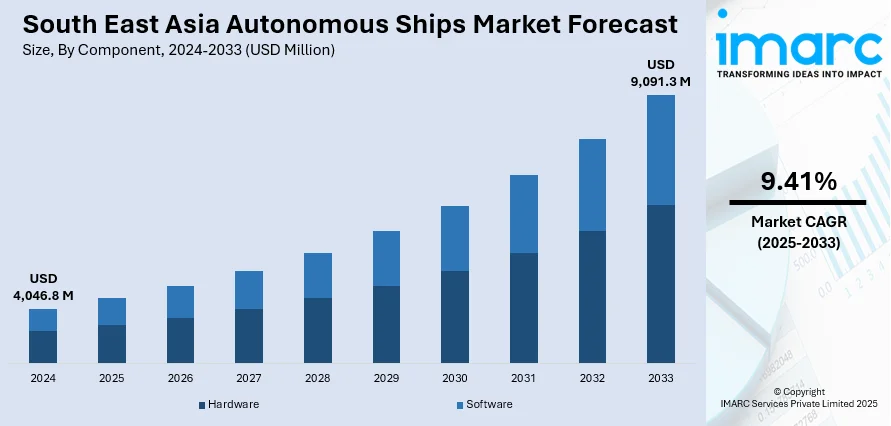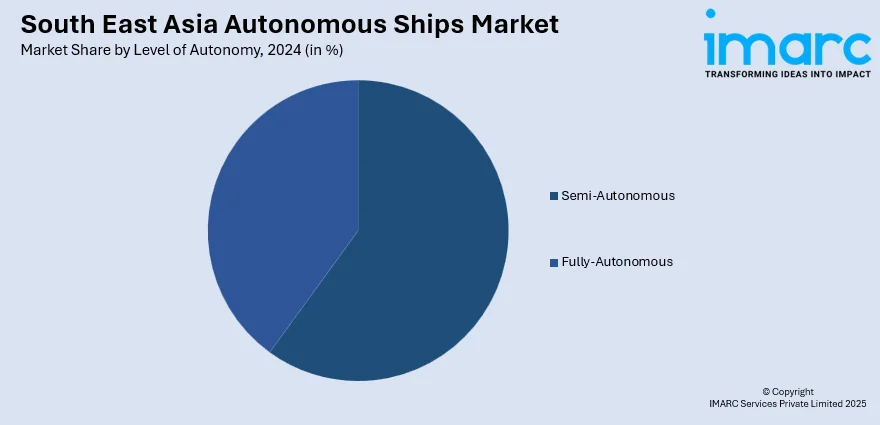
South East Asia Autonomous Ships Market Size, Share, Trends and Forecast by Component, Level of Autonomy, Fuel Type, Installation, Ship Type, and Country, 2025-2033
Market Overview:
South East Asia autonomous ships market size reached USD 4,046.8 Million in 2024. Looking forward, IMARC Group expects the market to reach USD 9,091.3 Million by 2033, exhibiting a growth rate (CAGR) of 9.41% during 2025-2033. The growing concerns about safety in the maritime industry, rising focus on sustainability and lowering the environmental impact of maritime transportation, and increasing collaborations between governing bodies, research institutions, and industry players represent some of the key factors driving the market.
|
Report Attribute
|
Key Statistics
|
|---|---|
|
Base Year
|
2024 |
|
Forecast Years
|
2025-2033
|
|
Historical Years
|
2019-2024
|
| Market Size in 2024 | USD 4,046.8 Million |
| Market Forecast in 2033 | USD 9,091.3 Million |
| Market Growth Rate (2025-2033) | 9.41% |
Autonomous ships are vessels that perform without a crew onboard, relying on advanced technology and artificial intelligence (AI) systems to navigate, control, and manage various operations of the ships. They are designed to perform tasks traditionally carried out by human crew members, such as navigation, collision avoidance, and cargo handling, autonomously. They are equipped with a wide range of sensors, including cameras, lidar, and environmental sensors, to perceive their surroundings accurately. They come in various types, ranging from small unmanned boats used for research purposes to large cargo vessels. They rely on robust communication systems to transmit data and receive instructions, which is essential for remote control and coordination with onshore operators. They lower the risk of accidents caused by human error, fatigue, or adverse weather conditions, enhancing overall safety at sea. They can optimize routes, reduce fuel consumption, and operate around the clock, leading to increased efficiency and cost savings for shipping companies. They can gather vast amounts of data about ocean conditions, which can be valuable for scientific research and environmental protection. They have the potential to address the shortage of skilled seafarers in the industry.

To get more information on this market, Request Sample
South East Asia Autonomous Ships Market Trends:
At present, increasing innovations in sensors, AI, and communication systems to enable the development of highly sophisticated autonomous vessels represent one of the key factors impelling the market growth in South East Asia. These cutting-edge technologies allow ships to navigate safely, avoid collisions, and make real-time decisions without human intervention. Additionally, the growing concerns about safety in the maritime industry is driving the demand for autonomous ships equipped with advanced sensors and AI algorithms that can detect potential hazards and navigate through challenging conditions with precision. The risk of human error, which is a substantial cause of maritime accidents, is significantly reduced in autonomous ships. Apart from this, the rising focus on sustainability and lowering the environmental impact of maritime transportation is encouraging the adoption of autonomous ships to optimize and minimize fuel consumption and emissions and contributing to a greener and more eco-friendly shipping industry. In addition, increasing collaborations between governing bodies, research institutions, and industry players are fostering innovation to enhance the capabilities and safety of autonomous vessels. These collaborative efforts are instrumental in overcoming technical challenges and ensuring the successful integration of autonomous ships into the regional maritime infrastructure. Moreover, the growing adoption of autonomous ships in specialized industries like offshore oil and gas exploration, fisheries, and research to perform tasks in challenging environments, such as deep-sea exploration or remote fishing grounds, with precision and cost-efficiency is offering a favorable market outlook in the region.
South East Asia Autonomous Ships Market Segmentation:
IMARC Group provides an analysis of the key trends in each segment of the market, along with forecasts at the regional and country levels for 2025-2033. Our report has categorized the market based on component, level of autonomy, fuel type, installation, and ship type.
Component Insights:
- Hardware
- Software
The report has provided a detailed breakup and analysis of the market based on the component. This includes hardware and software.
Level of Autonomy Insights:

- Semi-Autonomous
- Fully-Autonomous
A detailed breakup and analysis of the market based on the level of autonomy have also been provided in the report. This includes semi-autonomous and fully-autonomous.
Fuel Type Insights:
- Carbon Neutral Fuel
- Liquefied Natural Gas
- Electric Batteries
- Heavy Fuel Oil (HFO)
The report has provided a detailed breakup and analysis of the market based on the fuel type. This includes carbon neutral fuel, liquefied natural gas, electric batteries, and heavy fuel oil (HFO).
Installation Insights:
- OEM
- Retrofit
A detailed breakup and analysis of the market based on the installation have also been provided in the report. This includes OEM and retrofit.
Ship Type Insights:
- Commercial Ships
- Defense Ships
- Passenger Ships
The report has provided a detailed breakup and analysis of the market based on the ship type. This includes commercial ships, defense ships, and passenger ships.
Country Insights:
- Indonesia
- Thailand
- Singapore
- Philippines
- Vietnam
- Malaysia
- Others
The report has also provided a comprehensive analysis of all the major regional markets, which include Indonesia, Thailand, Singapore, Philippines, Vietnam, Malaysia, and Others.
Competitive Landscape:
The market research report has also provided a comprehensive analysis of the competitive landscape. Competitive analysis such as market structure, key player positioning, top winning strategies, competitive dashboard, and company evaluation quadrant has been covered in the report. Also, detailed profiles of all major companies have been provided.
South East Asia Autonomous Ships Market Report Coverage:
| Report Features | Details |
|---|---|
| Base Year of the Analysis | 2024 |
| Historical Period | 2019-2024 |
| Forecast Period | 2025-2033 |
| Units | Million USD |
| Scope of the Report | Exploration of Historical and Forecast Trends, Industry Catalysts and Challenges, Segment-Wise Historical and Predictive Market Assessment:
|
| Components Covered | Hardware, Software |
| Levels of Autonomy Covered | Semi-Autonomous, Fully-Autonomous |
| Fuel Types Covered | Carbon Neutral Fuel, Liquefied Natural Gas, Electric Batteries, Heavy Fuel Oil (HFO) |
| Installations Covered | OEM, Retrofit |
| Ship Types Covered | Commercial Ships, Defense Ships, Passenger Ships |
| Countries Covered | Indonesia, Thailand, Singapore, Philippines, Vietnam, Malaysia, Others |
| Customization Scope | 10% Free Customization |
| Post-Sale Analyst Support | 10-12 Weeks |
| Delivery Format | PDF and Excel through Email (We can also provide the editable version of the report in PPT/Word format on special request) |
Key Questions Answered in This Report:
- How has the South East Asia autonomous ships market performed so far and how will it perform in the coming years?
- What is the breakup of the South East Asia autonomous ships market on the basis of component?
- What is the breakup of the South East Asia autonomous ships market on the basis of level of autonomy?
- What is the breakup of the South East Asia autonomous ships market on the basis of fuel type?
- What is the breakup of the South East Asia autonomous ships market on the basis of installation?
- What is the breakup of the South East Asia autonomous ships market on the basis of ship type?
- What are the various stages in the value chain of the South East Asia autonomous ships market?
- What are the key driving factors and challenges in the South East Asia autonomous ships?
- What is the structure of the South East Asia autonomous ships market and who are the key players?
- What is the degree of competition in the South East Asia autonomous ships market?
Key Benefits for Stakeholders:
- IMARC’s industry report offers a comprehensive quantitative analysis of various market segments, historical and current market trends, market forecasts, and dynamics of the South East Asia autonomous ships market from 2019-2033.
- The research report provides the latest information on the market drivers, challenges, and opportunities in the South East Asia autonomous ships market.
- Porter's five forces analysis assist stakeholders in assessing the impact of new entrants, competitive rivalry, supplier power, buyer power, and the threat of substitution. It helps stakeholders to analyze the level of competition within the South East Asia autonomous ships industry and its attractiveness.
- Competitive landscape allows stakeholders to understand their competitive environment and provides an insight into the current positions of key players in the market.
Need more help?
- Speak to our experienced analysts for insights on the current market scenarios.
- Include additional segments and countries to customize the report as per your requirement.
- Gain an unparalleled competitive advantage in your domain by understanding how to utilize the report and positively impacting your operations and revenue.
- For further assistance, please connect with our analysts.
 Request Customization
Request Customization
 Speak to an Analyst
Speak to an Analyst
 Request Brochure
Request Brochure
 Inquire Before Buying
Inquire Before Buying




.webp)




.webp)












